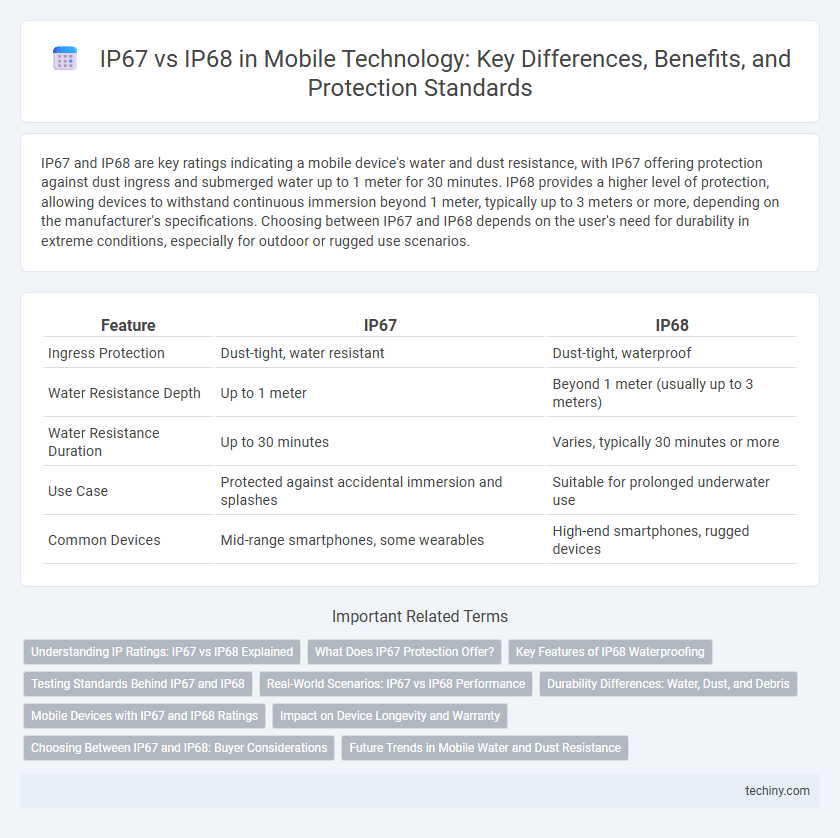IP67 and IP68 are key ratings indicating a mobile device's water and dust resistance, with IP67 offering protection against dust ingress and submerged water up to 1 meter for 30 minutes. IP68 provides a higher level of protection, allowing devices to withstand continuous immersion beyond 1 meter, typically up to 3 meters or more, depending on the manufacturer's specifications. Choosing between IP67 and IP68 depends on the user's need for durability in extreme conditions, especially for outdoor or rugged use scenarios.
Table of Comparison
| Feature | IP67 | IP68 |
|---|---|---|
| Ingress Protection | Dust-tight, water resistant | Dust-tight, waterproof |
| Water Resistance Depth | Up to 1 meter | Beyond 1 meter (usually up to 3 meters) |
| Water Resistance Duration | Up to 30 minutes | Varies, typically 30 minutes or more |
| Use Case | Protected against accidental immersion and splashes | Suitable for prolonged underwater use |
| Common Devices | Mid-range smartphones, some wearables | High-end smartphones, rugged devices |
Understanding IP Ratings: IP67 vs IP68 Explained
IP67 and IP68 ratings define the level of protection mobile devices have against dust and water ingress, with IP67 allowing immersion up to 1 meter for 30 minutes and IP68 offering enhanced water resistance typically beyond 1 meter and varying durations based on manufacturer specifications. These ratings are crucial for mobile technology users seeking durability in challenging environments, ensuring device functionality in conditions involving water exposure or dust infiltration. Understanding the specific depth and time limits associated with each IP rating helps consumers choose devices that match their usage needs and outdoor activity levels.
What Does IP67 Protection Offer?
IP67 protection ensures a device is fully dust-tight and can withstand immersion in water up to 1 meter deep for 30 minutes without damage. This rating guarantees robust resistance to dust ingress and short-term water exposure, making it ideal for everyday use and accidental splashes. Devices with IP67 certification provide reliable durability in various mobile technology environments where moisture and dust are common concerns.
Key Features of IP68 Waterproofing
IP68 waterproofing offers superior protection by allowing devices to be submerged in water up to 1.5 meters for 30 minutes, compared to IP67 which supports immersion up to 1 meter for the same duration. This enhanced rating ensures robust resistance against dust, dirt, and prolonged water exposure, making IP68 ideal for mobile technology users engaging in outdoor and underwater activities. The key features of IP68 include comprehensive sealing of ports, advanced gasket materials, and reinforced enclosure designs that maintain device functionality in harsh environments.
Testing Standards Behind IP67 and IP68
IP67 and IP68 standards define differing levels of dust and water resistance based on rigorous testing protocols set by the International Electrotechnical Commission (IEC) under IEC 60529. IP67 certifies protection against dust ingress and water immersion up to 1 meter for 30 minutes, while IP68 ensures device durability under continuous immersion beyond 1 meter, with specific depth and time parameters determined by manufacturers. These tests involve submerging devices in controlled water tanks and exposing them to dust chambers to validate their sealing efficiency and resilience in real-world mobile technology applications.
Real-World Scenarios: IP67 vs IP68 Performance
IP67-rated devices can withstand immersion in up to 1 meter of water for 30 minutes, making them ideal for accidental splashes or short submersions, such as dropping a phone in a shallow puddle. IP68 certification provides enhanced protection, allowing devices to endure continuous immersion beyond 1 meter, typically up to 1.5 meters for 30 minutes or more, suitable for activities like swimming in shallow water or use in heavy rain. Choosing between IP67 and IP68 depends on real-world usage needs, where IP68 offers superior water resistance for more demanding environments.
Durability Differences: Water, Dust, and Debris
IP67-rated devices offer protection against dust ingress and can withstand immersion in up to 1 meter of water for 30 minutes, making them durable against everyday spills and brief submersion. IP68-rated devices provide superior durability with dust-tight sealing and can endure continuous immersion beyond 1 meter, typically up to 3 meters, ensuring enhanced protection against prolonged water exposure and harsh environments. The key difference lies in IP68's ability to handle deeper and longer immersion, making it ideal for users needing robust protection in extreme conditions.
Mobile Devices with IP67 and IP68 Ratings
Mobile devices with IP67 ratings offer water resistance for temporary immersion up to 1 meter for 30 minutes, protecting against dust ingress. IP68-rated devices provide enhanced durability, withstanding continuous submersion beyond 1 meter, often specified by the manufacturer. Smartphones and tablets featuring IP68 certification deliver superior protection for users exposed to wet or dusty environments.
Impact on Device Longevity and Warranty
IP67 and IP68 ratings indicate a device's protection against dust and water, with IP68 offering deeper water resistance, typically beyond 1 meter for extended durations. Devices with an IP68 rating often experience enhanced longevity due to superior sealing against moisture ingress, which reduces the risk of internal damage. Manufacturers frequently provide more comprehensive warranties on IP68 devices, reflecting greater confidence in their durability under challenging environmental conditions.
Choosing Between IP67 and IP68: Buyer Considerations
IP67 and IP68 ratings define device protection levels against dust and water, with IP68 offering superior submersion depth and duration compared to IP67. Buyers prioritizing robust water resistance for activities like swimming or prolonged underwater exposure should opt for IP68-certified devices. For everyday use involving brief water contact or dust exposure, IP67 provides adequate protection while often being more cost-effective.
Future Trends in Mobile Water and Dust Resistance
IP67 and IP68 ratings are industry standards defining mobile devices' water and dust resistance, with IP68 offering greater protection against prolonged submersion. Future trends in mobile technology emphasize advancing these ratings to include higher depths and longer durations, integrating nanocoatings and self-healing materials to enhance durability. Innovations in IP certification are expected to drive enhanced user experience by ensuring device resilience in increasingly rugged environments.
IP67 vs IP68 Infographic

 techiny.com
techiny.com